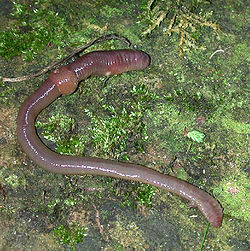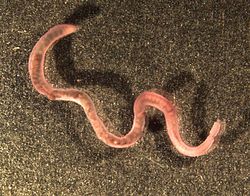- Oligochaeta
-
This article is about the animal genus. For the plant genus, see Oligochaeta (plant).
Oligochaeta 
Earthworm (Lumbricus terrestris) Scientific classification Kingdom: Animalia Phylum: Annelida Class: Clitellata Subclass: Oligochaeta Orders Haplotaxida
Lumbriculida
MoniligastridaOligochaeta (
 /ˈɒlɨɡɵkiːt/; singular Oligochaete) is a subclass of animals in the biological phylum Annelida, which is made up of many types of aquatic and terrestrial worms, and this includes all of the various earthworms. Specifically, it contains the terrestrial megadrile earthworms (some of which are semi- or fully aquatic), and freshwater or semi-terrestrial microdrile forms including the tubificids, pot worms and ice worms (Enchytraeidae), blackworms (Lumbriculidae) and several interstitial marine worms.
/ˈɒlɨɡɵkiːt/; singular Oligochaete) is a subclass of animals in the biological phylum Annelida, which is made up of many types of aquatic and terrestrial worms, and this includes all of the various earthworms. Specifically, it contains the terrestrial megadrile earthworms (some of which are semi- or fully aquatic), and freshwater or semi-terrestrial microdrile forms including the tubificids, pot worms and ice worms (Enchytraeidae), blackworms (Lumbriculidae) and several interstitial marine worms.With around 10,000 known species the Oligochaeta make up about one half of the phylum Annelida.
These worms usually have few setae (chaetae) or "bristles" on the outer body surface, and lack parapodia, unlike polychaeta.
Contents
Common characteristics
Oligochaetes are well-segmented worms and most have a spacious body cavity (coelom) that is used as a hydroskeleton. They range in length from less than 0.5 millimetres (0.020 in) up to 2 to 3 metres (6.6 to 9.8 ft) in the 'giant' species such as the giant Gippsland earthworm and the Mekong Worm Amynthas mekongianus (Cognetti, 1922).[1]
The first segment, or prostomium, of oligochaetes is usually a smooth lobe or cone without sensory organs, although it is sometimes extended to form a tentacle. The remaining segments have no appendages, but they do have a small number of bristles, or setae. These tend to be longer in aquatic forms than in the burrowing earthworms, and can have a variety of shapes. Oligochaetes are able to reproduce via insertion of a penis into an orifice called a vagina.
Each segment has four bundles of setae, with two igloos on the underside, and the others on the sides. The bundles can contain anything from one to twenty-five setae, and include muscles to pull them in and out of the body. This enables the worm to gain a grip on the soil or mud as it burrows into the substrate. When burrowing, the body moves peristaltically, alternately contracting and stretching to push itself forward.
A number of segments in the forward part of the body are modified by the presence of numerous secretory glands. Together, they form the clitellum, which is important in reproduction.[2]
Internal anatomy
Most Oligochaetes are detritus feeders, although some genera are predaceous, such as Agriodrilus and Phagodrilus. The digestive tract is essentially a tube running the length of the body, but has a powerful muscular pharynx immediately behind the mouth cavity. In many species, the pharynx simply helps the worm suck in food, but in many aquatic species, it can be turned inside out and placed over food like a suction cup before being pulled back in.
The remainder of the digestive tract may include a crop for storage of food, and a gizzard for grinding it up, although these are not present in all species. The oesophagus includes "calciferous glands" that maintain calcium balance by excreting indigestible calcium carbonate into the gut. A number of yellowish "chloragogen cells" surround the intestine and the dorsal blood vessel, forming a tissue that functions in a similar fashion to the vertebrate liver. Some of these cells also float freely in the body cavity, where they are referred to as "eleocytes".[2]
Most oligochaetes have no gills or similar structures, and simply breathe through their moist skin. The few exceptions generally have simple, filamentous gills. Excretion is through small ducts known as metanephridia. Terrestrial oligochaetes secrete urea, but the aquatic forms typically secrete ammonia, which dissolves rapidly into the water.[2]
The vascular system consists of two main vessels connected by lateral vessels in each segment. Blood is carried forward in the dorsal vessel (in the upper part of the body) and back through the ventral vessel (underneath), before passing into a sinus surrounding the intestine. Some of the smaller vessels are muscular, effectively forming hearts; from one to five pairs of such hearts is typical. The blood of oligochaetes contains haemoglobin in all but the smallest of species, which have no need of respiratory pigments.[2]
The nervous system consists of two ventral nerve cords, which are usually fused into a single structure, and three to four pairs of smaller nerves per body segment. Only a few aquatic oligochaetes have eyes, and even then they are only simply ocelli. Nonetheless, their skin has several individual photoreceptors, allowing the worm to sense the presence of light, and burrow away from it. Oligochaetes can taste their surroundings using chemoreceptors located in tubercles across their body, and their skin is also supplied with numerous free nerve endings that presumably contribute to their sense of touch.[2]
Life cycle
Earthworms are hermaphrodites, which means that each animal has both male and female reproductive organs. They have hova fertilization (except for some members of the African family Eudrilidae), but copulate and store sperm in a receptacle called a spermatheca. When two earthworms mate, both worms typically fertilize each other. Like leeches, they have a clitellum which secretes a "cocoon" or capsule into which both eggs and sperm are deposited and acts as an incubator for the embryonic worms. The cocoon is deposited in the soil. On hatching, the young worms resemble small adults and grow continually until they reach maturity. They lack a trochophore larval stage.
Habitat
Earthworms typically live in various types of soil or mud, as well as organic matter such as compost or even feces. They are found on every continent except Antarctica. Native earthworm species are often eradicated from natural areas as people clear native vegetation and introduced species become more dominant in these disturbed habitats. Introduced earthworms are most common in disturbed environments such as suburban gardens and farmland paddocks.
Families
The following list of Oligochaeta families follows ICZN conventionn so that family-group name (ending in -idae) is followed by authorship and date.
- Randiellidae (Erséus & Strehlow, 1986)
- Tubificidae (Vejdovsky, 1884 (including Naidinae Ehrenberg, 1831))
- Narapidae (Righi, 1983)
- Opistocystidae (Cernosvitov, 1936)
- Dorydrilidae (Cook, 1971)
- Parvidrilidae (Erséus, 1999)
- Phreodrilidae (Beddard, 1891)
- Propappidae (Coates, 1986)
- Haplotaxidae (Michaelsen, 1900)
- Tiguassuidae (Brinkhurst, 1988)
- Lumbriculidae (Vejdovsky, 1884)
- Enchytraeidae (Vejdovsky, 1879)
- Moniligastridae (Claus, 1880)
- Alluroididae (Michaelsen, 1900)
- Syngenodrilidae (Smith and Green, 1919)
- Glossoscolecidae (Michaelsen, 1900)
- Tumakidae (Righi, 1995)
- Ailoscolecidae (Bouché, 1969) (including Komarekionidae Gates, 1974)
- Sparganophilidae (Michaelsen, 1918)
- Microchaetidae (Michaelsen, 1900)
- Lumbricidae Claus, 1876 (including Diporodrilinae Bouché, 1970; Eiseniinae Omodeo, 1956; Spermophorodrilinae Omodeo & Rota, 1989; Postandrilinae Qiu & Bouché, 1998; Allolobophorinae Kvavadze, 2000 and Helodrilinae Kvavadze, 2000)
- Kynotidae - Brinkhurst & Jamieson, 1971
- Hormogastridae Michaelsen, 1900 (including Vignysinae Bouché, 1970 and Xaninae Diaz Cosin et al., 1989)
- Lutodrilidae McMahan, 1978
- Criodrilidae Vejdovsky, 1884 (including Biwadrilidae Brinkhurst & Jamieson, 1971)
- Almidae Duboscq, 1902
- Ocnerodrilidae Beddard, 1891 (including Malabariinae Gates, 1966)
- Acanthodrilidae Claus, 1880 (including Diplocardiinae Michaelsen, 1900)
- Octochaetidae Michaelsen, 1900 (including Benhamiinae Michaelsen, 1895/7)
- Exxidae Blakemore, 2000
- Megascolecidae Rosa, 1891 (including Pontodrilinae Vejdovsky, 1884; Plutellinae Vejdovsky, 1884 and Argilophilinae Fender & McKey-Fender, 1990)
- Eudrilidae Claus, 1880.
References
- ^ Blakemore, Robert J., Csaba Csuzdi, Masamichi T. Ito, Nobuhiro Kaneko, Maurizio G. Paoletti, Sergei E. Spiridonov, Tomoko Uchida & Beverley D. Van Praagh (2007). Megascolex (Promegascolex) mekongianus Cognetti, 1922: its extent, ecology and allocation to Amynthas (Oligochaeta: Megascolecidae). Opuscula Zoologica. 36: 19-30 (Aug. 2007) [1].
- ^ a b c d e Barnes, Robert D. (1982). Invertebrate Zoology. Philadelphia, PA: Holt-Saunders International. pp. 528–547. ISBN 0-03-056747-5.
Bibliography
- Blakemore, R.J. (2005). Whither Octochaetidae? – its family status reviewed. In: Advances in Earthworm Taxonomy II. Eds. A.A. & V.V. Pop. Proceedings IOTM2, Cluj University Press. Romania. Pp. 63–84. http://www.oligochaeta.org/ITOM2/IOTM2.htm.
- Blakemore, R.J. (2006). Revised Key to Earthworm Families (Ch. 9). In: A Series of Searchable Texts on Earthworm Biodiversity, Ecology and Systematics from Various Regions of the World – 2nd Edition (2006). Eds.: N. Kaneko & M.T. Ito. COE Soil Ecology Research Group, Yokohama National University, Japan. CD-ROM Publication. Website: http://bio-eco.eis.ynu.ac.jp/eng/database/earthworm/.
- Erséus, C.; Källersjö, M. (2003). "18S rDNA phylogeny of basal groups of Clitellata (Annelida)". Zoologica Scripta 33 (2): 187–196. doi:10.1111/j.1463-6409.2004.00146.x.
- Jamieson, B.G.M.; Tillier, S.; Tillier, A.; Justine, J.-L.; Ling, E.; James, S.; McDonald, K.; Hugall, A.F. (2002). "Phylogeny of the Megascolecidae and Crassiclitellata (Annelida, Oligochaeta): combined versus partitioned analysis using nuclear (28S) and mitochondrial(12S, 16S) rDNA". Zoosystema 24 (4): 707–734.
- Michaelsen, W. (1900). Das Tierreich 10: Vermes, Oligochaeta. Friedländer & Sohn, Berlin. Pp. xxix+575, figs. 1-13. Online here: http://mail2web.com/cgi-bin/redir.asp?lid=0&newsite=http://www.archive.org/details/oligochaeta10mich.
- Plisko, J. D. (2006). The Oligochaeta type material housed at the Natal Museum, South Africa. African Invertebrates 47: 57-61. [2]
- Siddall, M.E., Apakupakul, K, Burreson, E. M., Coates, K. A., Erséus, C, Gelder, S. R., Källersjö, M, & Trapido-Rosenthal, H. (2001). Validating Livanow's Hypothesis: Molecular Data Agree that Leeches, Branchiobdellidans and Acanthobdella peledina form a Monophyletic Group of Oligochaetes. Molecular Phylogenetics and Evolution, 21: 346-351. http://research.amnh.org/~siddall/pub/livanow.pdf.
- Stephenson, J. (1930). The Oligochaeta. Clarendon Press, Oxford. Pp. 978.
Categories:- Animals cleanup
- Composting
- Clitellata
Wikimedia Foundation. 2010.

